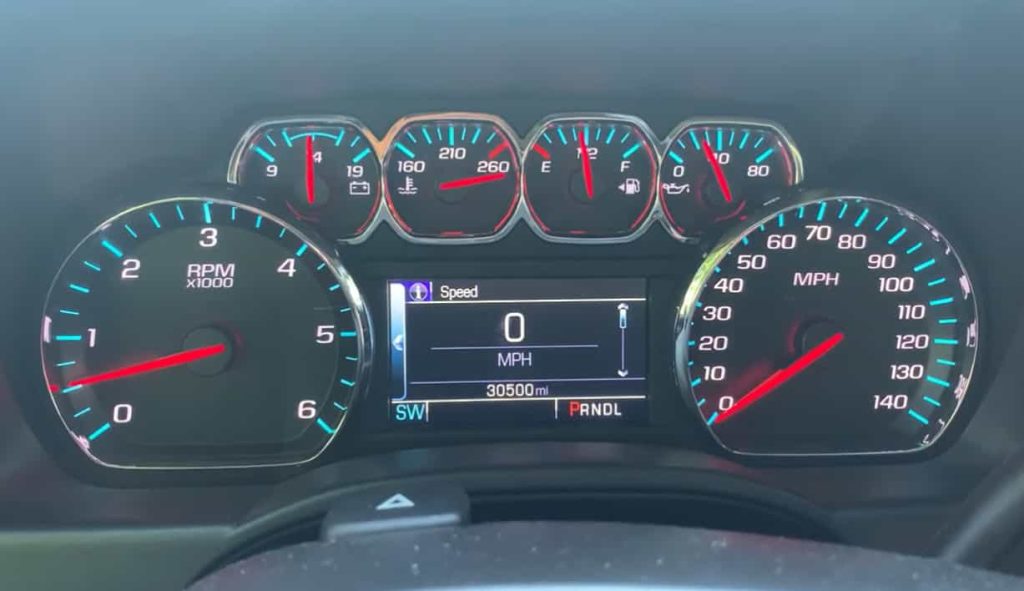Is your 2014 Silverado temperature gauge not working?
You rely on your temperature gauge for a number of reasons. But when it is malfunctioning, then you may encounter some problems with the performance of your vehicle.
There are certain causes behind a faulty temperature gauge. For instance, the temperature sending unit may be broken, or there may be an issue in the electrical circuit of your temperature gauge.
A few more reasons are linked with this malfunction. Today, we will discuss what these reasons are, as well as some tips you can try to fix your 2014 Silverado temperature gauge not working. Let’s jump right into it.

Causes Of 2014 Silverado Temperature Gauge Not Working
You need to make sure your temperature gauge is working to prevent overheating issues with your engine.
However, what if the gauge is not reading correctly?
First of all, the temperature sensor is what reads your engine temperature. So, when your temperature gauge shows its reading, you can tell if the engine is at its optimal temperature. It also allows you to identify any other concerns such as fluctuations with the temperature or overheating.
Now, there is a sending unit to this gauge called the thermistor. The variable resistance generates a reaction to coolant temperature changes. When you have a cool engine, which happens when you have just started your vehicle, you can see a high resistance in your sending unit. This prevents an electrical current flow.
But as the coolant starts to warm up, you can see the resistance decreasing as it should. Then, the indicator in your gauge will start to rise. The reading will stay at the middle of your reading scale, as long as you maintain a certain operating temperature for your engine. You also won’t see any warning light unless there is an overheating issue with your engine.
Back then, the sending unit used to send information straight to temperature gauges. However, newer models of vehicles now have a computer where it is the interface for the sending unit and the gauge.
Now, it is important to determine if the issue is with the gauge or the engine. When you see a very low or very high reading from your temperature gauge, you won’t be able to tell easily if the issue is with your gauge, engine, or perhaps another cause. Of course, you can identify which one is at fault once steam comes out of your hood and the gauge reads very high. But you most certainly would not wait for this to happen.
Most of the time, you can rely on the accuracy of the temperature gauge. But you need to know for sure by conducting a simple diagnostic check. You need to perform this quick inspection after running the engine for over 20 minutes. Or, once you notice the gauge shows an overheating problem.
When you open the hood, check if your coolant level is “full hot” on its tank. If the level is low, it can cause your engine to overheat.
In case you have no recovery or reservoir tank, allow your engine to get cooler and inspect the level through your radiator neck. It should be at a half an inch level right below the bottom but over your radiator core.
Observe the coolant’s color, which should either be orange or green. When it appears cloudy or rusty, it is possibly contaminated. This is also a culprit for overheating.
Then, check the cooling fan. The ideal speed upon start is 110 celsius. If it fails to start, this can lead to engine overheating. You should also compare how the engine head feels and your upper radiator hose. These should feel hot. However, if you notice that the hose is either warm or cool yet the engine is hot, the thermostat may be stuck on the closed position or you have a clogged radiator. Your engine is at risk of overheating.
But if both the engine and the hose feel slightly warm, your thermostat may be open and this prevents your engine from getting to its operating temperature. This is why your gauge reads lower than the ideal temperature.
When you have a low temperature gauge reading, it is possible that your cooling system has an issue. It could be due to a low coolant level, faulty gauge, temperature sending unit issue, or the thermostat is stuck open.
In case the gauge is reading high, you may have a problem with your radiator and reservoir tank. It could also be due to leaks in your water pump, hoses, cylinder head gasket, radiator, and heater core.
It is typical for your gauge to rise over the middle range as you drive in heavy traffic. This is also the case when you are carrying a heavy load or ascending a steep hill. But when the gauge is on the higher end of your scale – and you are in a normal driving situation, the cooling system is likely the issue.
If you notice fluctuations with your temperature gauge, there may be problems with your coolant level. A low coolant level delays the closing and opening of your thermostat. Or, you may be having a coolant leakage, loose drive belt, clogged radiator, faulty temperature gauge, or a blown head gasket.
We recommend checking these relevant components, as well as the temperature sending unit, which are more likely to fail and can cause the 2014 Silverado temperature gauge not working.
Read More: What Year Silverado Wheels Are Interchangeable? Key Points To Keep In Mind
Final Thoughts
It is never easy having to deal with problems with your vehicle. Most importantly, if you have a 2014 Silverado temperature gauge not working, this can increase the possibility of an engine overheating issue. So, it is best to get your temperature gauge checked and fixed – or to inspect other possible causes of the problem sooner than later.